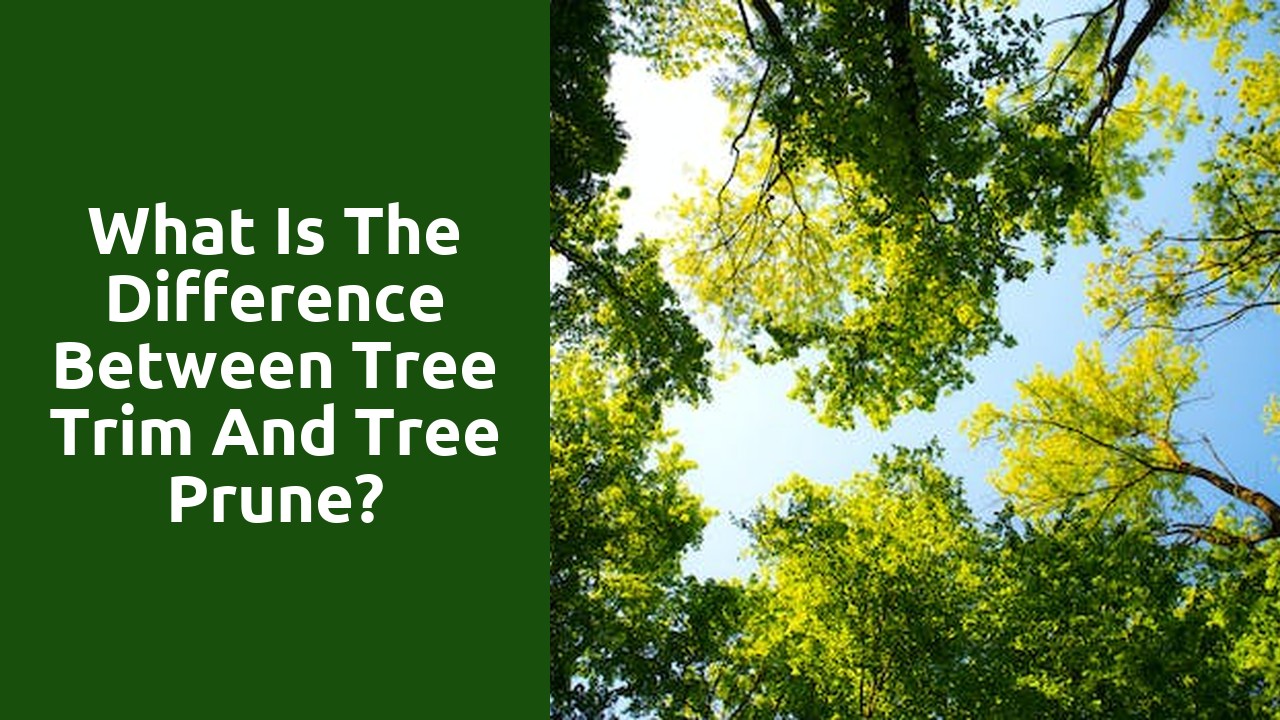What is the difference between tree trim and tree prune?

Tree Care Basics
Proper tree care is essential for the health and longevity of these magnificent organisms. From planting to pruning, understanding the basics can help ensure that your trees thrive for years to come. When it comes to planting a new tree, it's crucial to select the right location. Consider the mature size of the tree and ensure there is enough space for its roots to spread without obstruction. Additionally, it's vital to provide adequate sunlight and moisture for the tree's growth. Regular watering and mulching can help maintain soil moisture and protect the tree's roots from extreme temperatures. Pruning is another critical aspect of tree care. Removing dead or diseased branches not only improves the tree's appearance but also promotes healthy growth. However, it's important not to over-prune, as this can weaken the tree and make it more susceptible to pests and diseases.
View this external resource for great tips and advice.Trimming vs Pruning: Understanding the Difference
Trimming and pruning are two essential techniques used in gardening and arboriculture to maintain the health and aesthetics of plants and trees. While these terms are often used interchangeably, they actually refer to different practices. Trimming generally involves the removal of overgrown or dead branches or foliage, primarily for aesthetic purposes. By trimming away unwanted growth, plants can be shaped to enhance their appearance, encourage fuller growth, and prevent potential hazards like obstructing sidewalks or windows.
Pruning, on the other hand, focuses more on the overall health and well-being of the plant. It entails the selective removal of specific branches or parts of a plant to improve its structure, stimulate growth, and promote better airflow and light penetration. Pruning is primarily done to remove damaged or diseased sections, to control the size and shape of a tree, or to direct its growth pattern. Additionally, pruning can help rejuvenate an aging plant and increase its resistance to pests and diseases.
The Purpose of Tree Trimming
Tree trimming serves multiple purposes and is an essential practice for maintaining the health and structural integrity of trees. One of the primary reasons for trimming is to promote the safety of nearby structures and people. Overgrown branches can pose a significant risk, especially during strong winds or storms. By removing dead or weak branches, tree trimming reduces the chances of them falling and causing damage. It also helps maintain a safe distance from power lines, preventing potential electrical hazards.
Another vital purpose of tree trimming is to enhance the overall appearance and aesthetics of trees and landscapes. Regular pruning not only improves the shape and symmetry of trees but also allows for better air circulation and sunlight penetration. Trimming away excessive foliage promotes healthier growth and can prevent the development of diseases and pest infestation. Additionally, well-maintained trees can greatly enhance the curb appeal of a property, contributing to its overall value.
The Purpose of Tree Pruning
Tree pruning is an essential practice carried out to enhance the overall health and appearance of trees. By removing dead, damaged, or overgrown branches, pruning promotes better air circulation and sunlight exposure, which are crucial for a tree's growth. Furthermore, this process reduces the risk of branch breakage during storms or high winds, making the trees more resilient. Proper pruning can also help prevent the spread of diseases or pests, as it creates a healthier environment for the tree.
In addition to improving the tree's health, pruning also plays a vital role in shaping its form and structure. By selectively removing certain branches, arborists can guide the growth of the tree, creating a visually pleasing shape or encouraging specific branching patterns. Pruning can also be carried out to mitigate potential hazards, such as removing branches that are too close to power lines or structures. Overall, proper pruning not only enhances the aesthetic value of trees but also contributes to their safety and longevity.
Key Techniques Used in Tree Trimming
For effective and efficient tree trimming, several key techniques are employed by skilled professionals. One such technique is known as "crown reduction." This technique involves selectively pruning certain branches at the top of the tree in order to reduce its overall size. Crown reduction not only helps to maintain the tree's natural shape but also stimulates new growth and enhances its overall health.
Another commonly used technique is "crown thinning." This method focuses on carefully removing specific branches throughout the crown of the tree to increase light penetration and improve air circulation. By removing congested or crossing branches, crown thinning allows for a healthier and more aesthetically pleasing tree. Additionally, this technique reduces the risk of branches rubbing against each other, which can result in damage or disease.
Key Techniques Used in Tree Pruning
One of the fundamental techniques used in tree pruning is crown thinning. This process involves selectively removing branches from the tree's crown to reduce its density. By removing certain branches, more light and air can penetrate through the crown, promoting healthy growth and preventing diseases. Crown thinning also helps to improve the tree's structure and prevents branches from becoming too crowded or crossing over each other.
Another key technique in tree pruning is crown raising. This involves removing lower branches of the tree to create clearance underneath. Crown raising is especially important in urban areas where trees are often located near buildings, sidewalks, or roads. By removing lower branches, the tree's canopy is lifted higher, allowing pedestrians, vehicles, and buildings to have unobstructed access while also enhancing visibility and safety. This technique also helps to prevent damage caused by rubbing branches or low-hanging limbs.
Related Links
Does pruning mean trimming?What are 3 most common types of pruning?